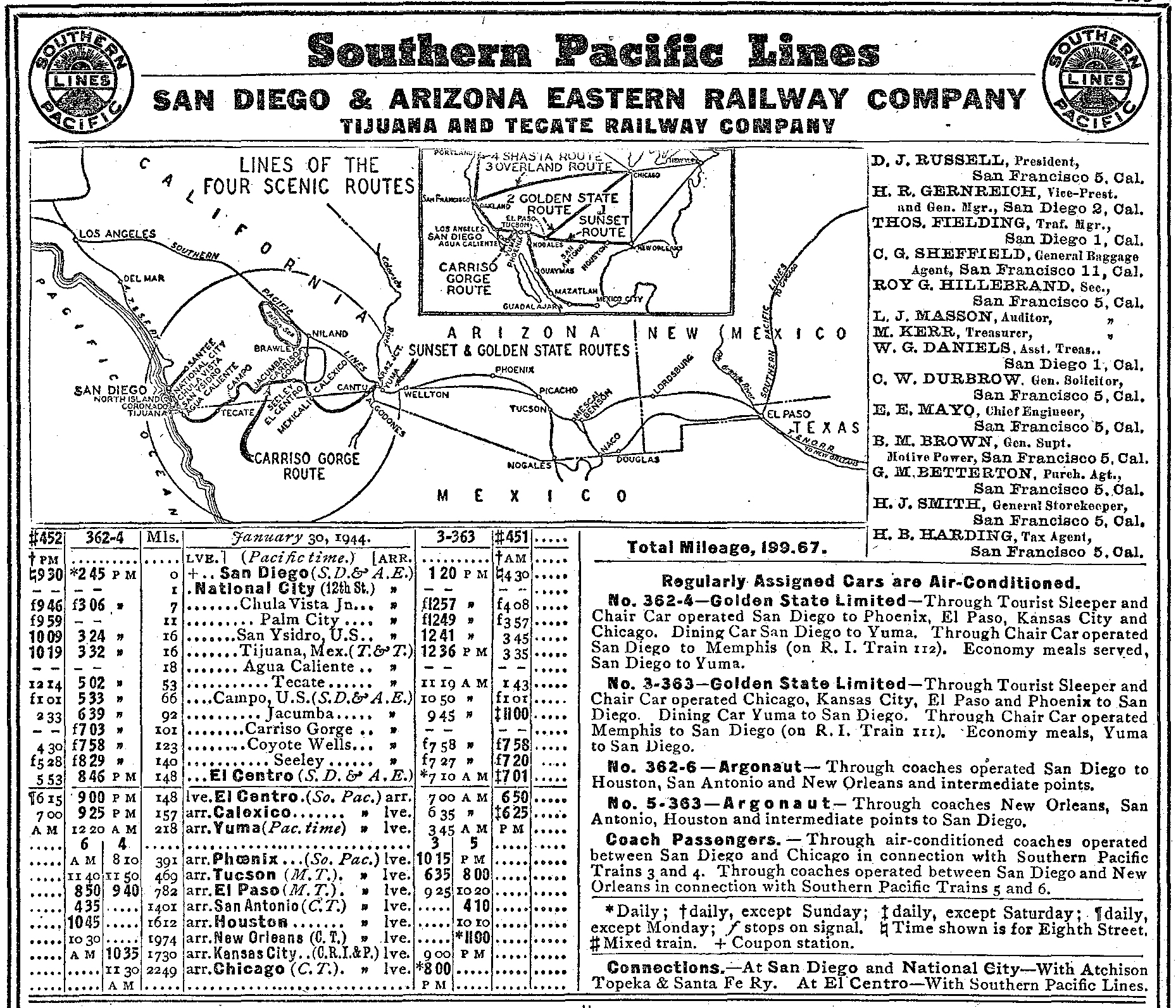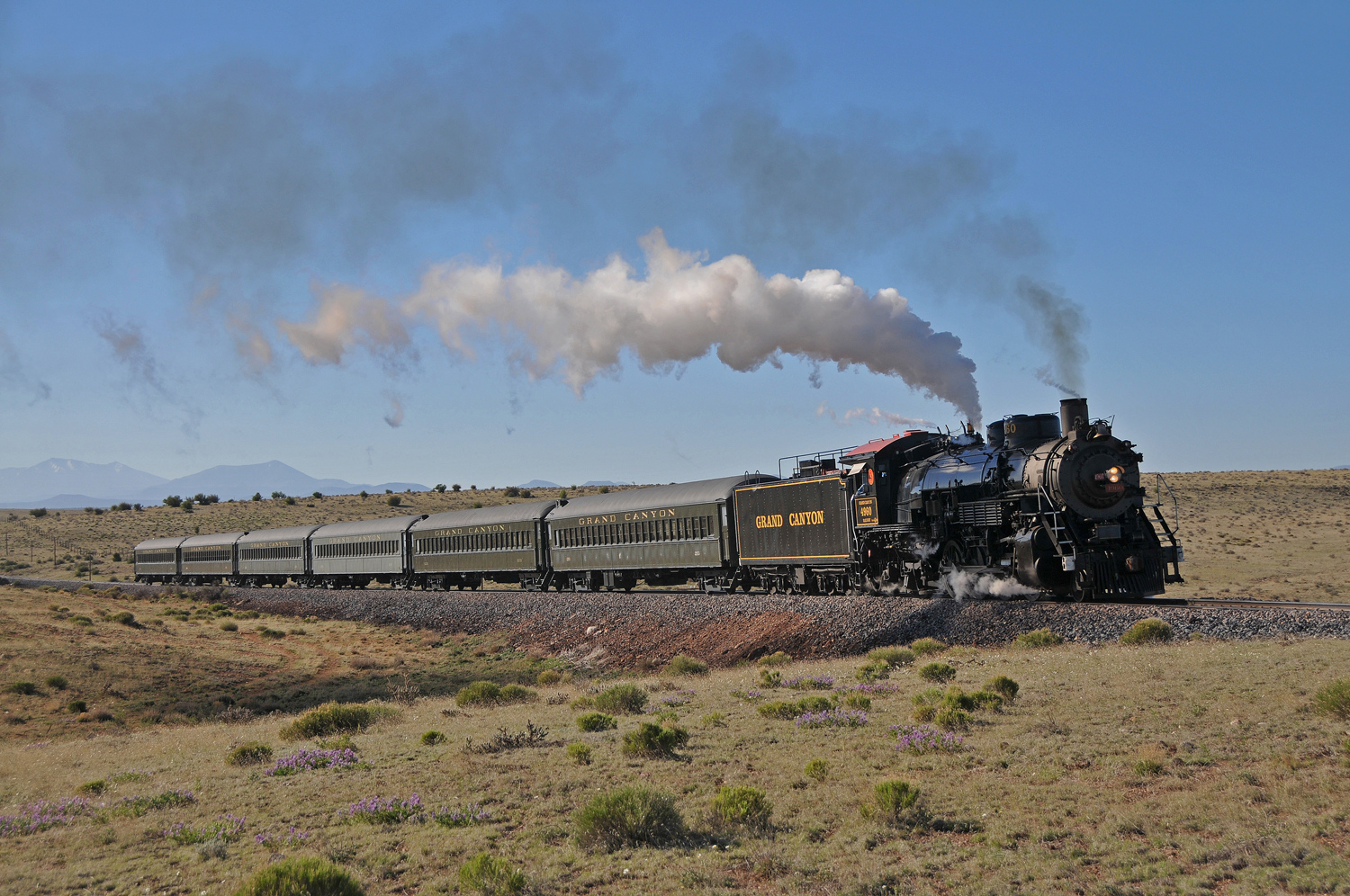San Diego and Arizona Eastern Railway: Map, History, Timetables
Published: February 17, 2025
By: Adam Burns
The San Diego and Arizona Eastern Railway (SD&AE) was more than just a means of transportation; it was a symbol of ambition, tenacity, and the transformative power of railroads in early 20th-century America.
The system was established in 1932 as the successor to the San Diego & Arizona Railway (SD&A), originally founded in 1906 by the entrepreneur John D. Spreckels. Often referred to as the "Impossible Railroad" due to its challenging construction across harsh terrains, the SD&AE was built specifically to provide San Diego with a direct rail corridor to eastern markets.
Since 1979, ownership of the SD&AE has been held by the San Diego Metropolitan Transit Development Board and its successor, the San Diego Metropolitan Transit System.
There have been many attempts to reopen the line for passenger and freight service but the entire route has not been utilized since 2008.
Map and Timetable (1945)
Conception and Early Efforts
The origins of the SD&AE can be traced back to the dreams of several visionary entrepreneurs and community leaders who saw immense potential in connecting San Diego with the eastern parts of the country.
In the late 19th century, John D. Spreckels, a prominent businessman with interests in sugar, shipping, and real estate, became a pivotal figure in advocating for the construction of this railway. At the time, transportation options for connecting San Diego to other parts of the country were limited and cumbersome, hindering economic growth and development.
The idea was to create a direct rail link across the treacherous terrains of the Peninsular Ranges and the Sonoran Desert to connect with the Southern Pacific Railroad in Yuma, Arizona.
While this concept was ambitious, the geographical challenges were significant. Nevertheless, Spreckels, with his entrepreneurial spirit, acquired several existing small railroads and initiated the project under the San Diego & Arizona Railway Company on December 14, 1906.
In 1909, the San Diego & Arizona Railway Company (SD&A) formalized an arrangement with the Mexican Government to extend their tracks across the border. As a stipulation of this agreement, the SD&A was mandated to establish the Tijuana and Tecate Railway, which would be responsible for constructing and managing a 44-mile stretch of the railway within Mexico under a 99-year lease.
Construction Challenges
From its inception, the construction of the railroad faced numerous obstacles. The rugged landscape, characterized by steep mountains, deep canyons, and harsh desert conditions, made building the route an engineering nightmare.
The most daunting was the stretch known as Carrizo Gorge, which required extensive tunnel work – including the construction of the 600-foot-long Goat Canyon Trestle, which remains one of the largest curved wooden trestles ever built.
The construction teams in Mexico faced attacks from revolutionaries who sought to conscript soldiers, seize supplies, and sever communication lines. Stateside, in 1917, the U.S. federal government commandeered all railroads to preserve resources for World War I, halting construction temporarily. Work resumed only upon the reassessment that the SD&A would be instrumental in supporting military facilities.
The outbreak of World War I and subsequent material shortages further complicated efforts, causing delays and inflating costs. Labor difficulties and natural disasters, such as floods, landslides, and fires, repeatedly disrupted progress. Despite these issues, Spreckels remained determined, investing considerable resources into overcoming each challenge.
Completion and Operations
Against all odds, on November 15, 1919, the San Diego & Arizona Railway was completed at a cost of $18 million.
The inaugural run of the "Impossible Railroad" was celebrated with great fanfare and was hailed as a monumental achievement in engineering and determination. The line stretched 146 miles from San Diego to Calexico on the Mexican border, including crossing into Mexico itself.
The railway quickly became a vital link for transporting goods and passengers between San Diego and American Southwest. It facilitated the movement of agricultural produce, raw materials, and manufactured goods, thereby playing a key role in the economic development of the region.
Nevertheless, operational challenges persisted. Torrential rains between 1926 and 1929 severely eroded tracks east of San Diego, precipitating financial difficulties for the railway. In 1932, natural disasters including floods, landslides, and fires resulted in the closure of three tunnels, with repair costs exceeding $600,000.
Transition to San Diego and Arizona Eastern Railway
Following the death of John D. Spreckels in 1926, his heirs opted against enduring the railroad's financial strains and sold the SD&A to the Southern Pacific. It was subsequently reincorporated as the San Diego & Arizona Eastern Railway, marking a new chapter in its history. Under SP's management, efforts were made to modernize operations and maintain the line, but challenges persisted.
The line's profitability fluctuated over the decades, with sections frequently damaged by storms and landslides, requiring costly repairs. Notably, the construction of highways and the rise of automobile transportation reduced the passenger service appeal, forcing a focus on freight to sustain operations.
During the height of passenger rail travel the SP utilized the SD&AE as a through route for several notable trains, most notable the Imperial. The train gained its name from the region in which it operated, California's beautiful Imperial Valley located not far from the Mexican border.
Working in conjunction with the Rock Island the train operated from San Diego to Chicago via Tucumcari, New Mexico, operating from 1932 until August 18, 1967
Decline and Revival Efforts
The latter half of the 20th century saw further declines in rail transportation's prominence. The SD&AE discontinued local passenger service on January 11, 1951. On May 20, 1970, the SP ceded its interest in the Tijuana & Tecate Railway to the Mexican national railway, Ferrocarril Sonora–Baja California.
By 1976, sections of the SD&AE were deemed financially unsustainable, leading SP to seek abandonment of the track connecting to Yuma. However, due to the strategic importance of maintaining a cross-border link, the railroad found support from regional and government stakeholders interested in preserving the line for potential freight traffic, tourism, and strategic transit.
The San Diego Metropolitan Transit Development Board (MTDB) purchased the SD&AE line in 1979. The acquisition was driven by the vision of utilizing the line as a rail transit corridor while sustaining freight operations.
Several portions of the line were upgraded to accommodate trolley services, spearheading the development of the San Diego Trolley, which became the city's first modern light rail system, further embedding the line into San Diego's urban landscape.
Heritage and Legacy
Despite its challenges, the San Diego and Arizona Eastern Railway has left an indelible mark on the region's history. While parts of the original railway continue to serve freight and light rail services, segments have historical significance and are maintained for their heritage value.
The line is a testament to early 20th-century railroad engineering and the determination to conquer geographical barriers in pursuit of progress and development.
Rail enthusiasts and historians alike continue to celebrate the SD&AE's legacy, cherishing its fascinating story and the enduring structures like the Goat Canyon Trestle and numerous tunnels. The railway's history is often recounted through tours, museums, and societies dedicated to preserving the memory of this "Impossible Railroad."
Overview
In conclusion, the San Diego and Arizona Eastern Railway embodies the entrepreneurial spirit and resilience necessary to overcome tremendous odds.
From its visionary inception by John D. Spreckels to its contemporary role in urban transit and historical preservation, the SD&AE has contributed significantly to shaping the regional identity and economic landscape of Southern California and beyond.
Ranked as one of the most challenging railways ever built, its existence is a powerful reminder of human ingenuity's ability to redefine the possible.
Recent Articles
-
Florida Railroad Museums: A Complete Guide
Apr 17, 25 04:48 PM
Florida is home to many railroad museums preserving the state's rail heritage, including an organization detailing the great Overseas Railroad. -
Delaware Railroad Museums: A Complete Guide
Apr 17, 25 04:23 PM
Delaware may rank 49th in state size but has a long history with trains. Today, a few museums dot the region. -
Arizona Railroad Museums: A Complete Guide
Apr 16, 25 01:17 PM
Learn about Arizona's rich history with railroads at one of several museums scattered throughout the state. More information about these organizations may be found here.

